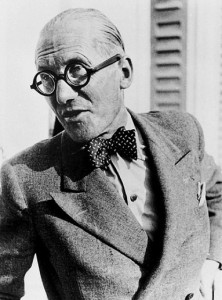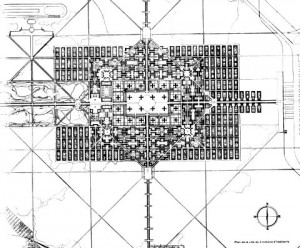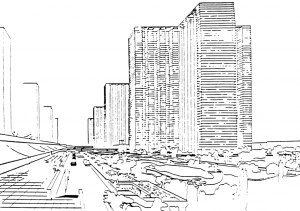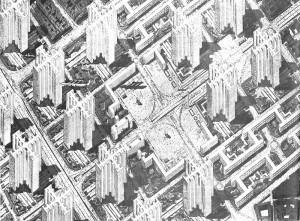By Le Corbusier
About the Author:

Painter, Architect, City Planner, Philosopher and Author, Le Corbusier (1887-1965) was one of the founding fathers of the Modernist movement. Born Charles-Edouard Jeanneret-Gris, Le Corbusier grew up in the Swiss town of La Chaux-de-Fonds, later he moved to Paris to pursue a career in Art and Architecture. His career spanning five decades, with his monumental buildings throughout Europe, America & India. He called his designs of modern houses ‘Machines of living’, they were strikingly original and of cubist minimalism. In 1922, Le Corbusier presented to the public his plan for “A Contemporary City of Three Million People”. Le Corbusier’s impact came not from cities he designed and built himself but from cities that were built by others incorporating the planning principles that he pioneered.
Date: 1922
Period: Modern movement (1900-1950)
Summary:
The contemporary city is meant to be for 3 million residence, the plan is centralised and organised according to a system of land uses with monumental axes cutting through.
A rigid geometrical distribution of uniform buildings with huge open spaces including a system of mass transportation.

The business section is in the heart of the city symbolising the centrality of the secular power, compromised of 25 glass skyscrapers, each with 60 storeys in height (5% of the surface area).

The next two belts contained residential blocks, stacked up with garden terraces grouped around interior courtyards or arranged in a linear pattern.
Beyond the residential blocks, is a vast area of greenery, placing gardens for workers and industrial districts, ports, or even sport complexes.

The main goal of the project was to facilitate traffic, therefore; fast automobile traffic was completely separated from pedestrians lanes.
The highways were elevated, intersecting the city from all sides and connecting the peripheral to the centre of the city while Pedestrian traffic was amid parks and gardens.

The Contemporary city was meant to achieve standardised principles of town planning, as the rigid geometry was a part of the machine aesthetics.
Le Corbusier presented a city solving the urban problems by separation & order.
Proposing a concept for utopian city by Illustrating the principles of the futurist movement of the 1920 at a grand scale, relying on management & technology as well as emphasising the importance of open spaces and parks, focusing on incorporating nature.
For more information click here
Relevant to Qatar:
Legates, R., & Frederic, S. The city reader. (5th ed.).
Contemporary city for three million inhabitants. (n.d.). Retrieved from http://www.architectural-world.com
Steyn, G. (n.d.). Le corbusier’s town-planning ideas and the ideas of history. Retrieved fromhttp://repository.up.ac.za/bitstream/handle/2263/21479/Steyn_LeCorbusier(2012).pdf?sequence=1
Fagan. (n.d.). Architectural futurism of the 1920s [Web]. Retrieved fromhttp://www.youtube.com/watch?v=rw8LNJ8gBq4
Additional Reference:
Susan , F., & Campbell , S. Readings in planning theory. (3rd ed.). Wiley blackwell A john wiley and sons
Published by: Amal AlKubaisi
